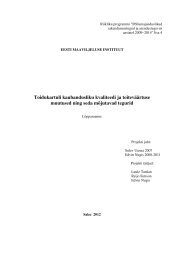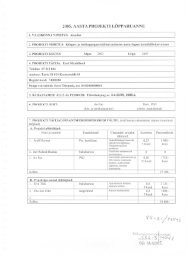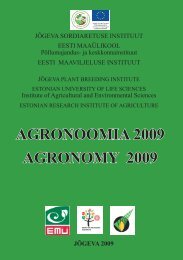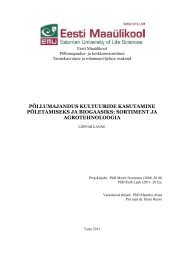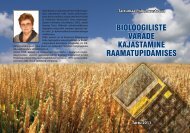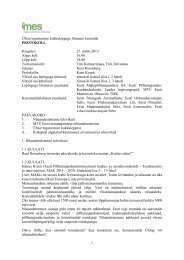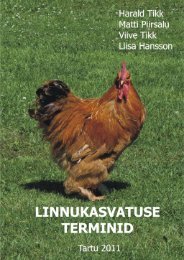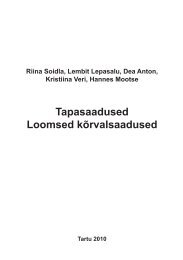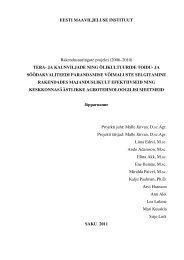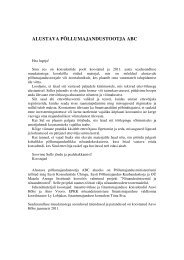Terve loom ja tervislik toit
Terve loom ja tervislik toit
Terve loom ja tervislik toit
You also want an ePaper? Increase the reach of your titles
YUMPU automatically turns print PDFs into web optimized ePapers that Google loves.
42 43<br />
Consumer Perceptions<br />
In a recent report (Blokhuis, 2005) European consumers’<br />
understanding of welfare were discussed, and it was concluded<br />
that consumers commonly conflate the terms animal welfare and<br />
food quality. If scientists, and indeed producers, separate these<br />
two concepts then we are doing consumers a disservice. It may<br />
be considered that consumers are muddling two entirely separate<br />
concepts, but it is hoped that this paper may provide some evidence<br />
that the consumer is not altogether wrong in this regard.<br />
This association of food quality with animal welfare by consumers<br />
is reported to be particularly strong in France, although there is<br />
evidence that consumers also make this connection in the UK (at<br />
least for milk (Ellis et al., 2009)). Labelling on food products was<br />
identified by Blokhuis as typifying this association, with such phrases<br />
as “Respect for taste and nature“ and “characteristics contributing<br />
to superior quality: free-range reared in the open-air…” identified<br />
on packaging in France. Furthermore, Blokhuis (2005) proposed<br />
that, in France and Italy, consumers are largely only interested in<br />
animal welfare if it is explicitly linked with food quality.<br />
Animal Welfare and Taste.<br />
If it is understood that the term food quality also includes the taste<br />
and the pleasure derived from a food product, what then are the<br />
impacts that the welfare of food animals has on the taste of the<br />
food produced by them Aside from any effects on the chemical or<br />
physical attributes of an animal food product, knowing the welfare<br />
provenance of a food item can affect consumers’ perception of<br />
the taste of that product. In blind taste tests of beef, organically<br />
produced beef scored higher than conventionally produced beef,<br />
but this difference was less than when testers knew the origin of the<br />
beef (Napolitano et al., 2009). Altzintzoglou et al. (2010) remarked<br />
on the different perceptions by consumers of the taste of products<br />
depending solely on the history of the welfare quality of the lives of<br />
the animals. The same product, different history, different tastes.<br />
This is not as surprising as might at first sight be expected. Taste<br />
is not only a matter of receptors on the tongue or the feel of food<br />
in the mouth, but a complex perception involving past experience<br />
and expectations (Troy and Kerry, 2010). It is therefore normal and<br />
understandable that consumers experience the taste of an animal<br />
welfare-friendly product differently from one that they understand<br />
to be of a more intensive production system. The food taste better<br />
from an animal that has been raised in conditions of good welfare<br />
not just for any intrinsic or causal reason, but simply because the<br />
consumer expects it to, or maybe wants it to.<br />
Mechanical damage to the carcase<br />
During the lifetime of livestock animals, and perhaps especially<br />
during their transport and slaughter (Bornett-Gauci et al., 2006),<br />
if welfare is poor, this can lead to damage to the carcase, and a<br />
consequent impairment of meat quality. This can be through<br />
bruising or injuries arising from poorly designed or checked housing,<br />
or from agonistic acts (biting, kicking, butting) from conspecifics<br />
or unsympathetic handling by stockmen. Broken bones, although<br />
found, are reported to occur infrequently, but the incidence of<br />
subcutaneous and muscular haemorrhaging is frequent (Mirandade<br />
La Lama et al., 2009) and such bruising of the muscle tissue<br />
impacts adversely on carcase quality assessment.<br />
At slaughter there are problems affecting welfare and<br />
carcase quality at stunning, particularly in poultry. If the current<br />
is too low the birds will not be effectively stunned but carcase<br />
quality will not be affected, but if it is too high all the birds will<br />
be stunned but the carcases may well be damaged, and the meat<br />
quality reduced. The problem is that individual chickens have a<br />
wide variation of impedance (Wotton and Wilkins, 2004) and so<br />
some chickens are invariably not stunned and some carcases are<br />
invariably damaged.





